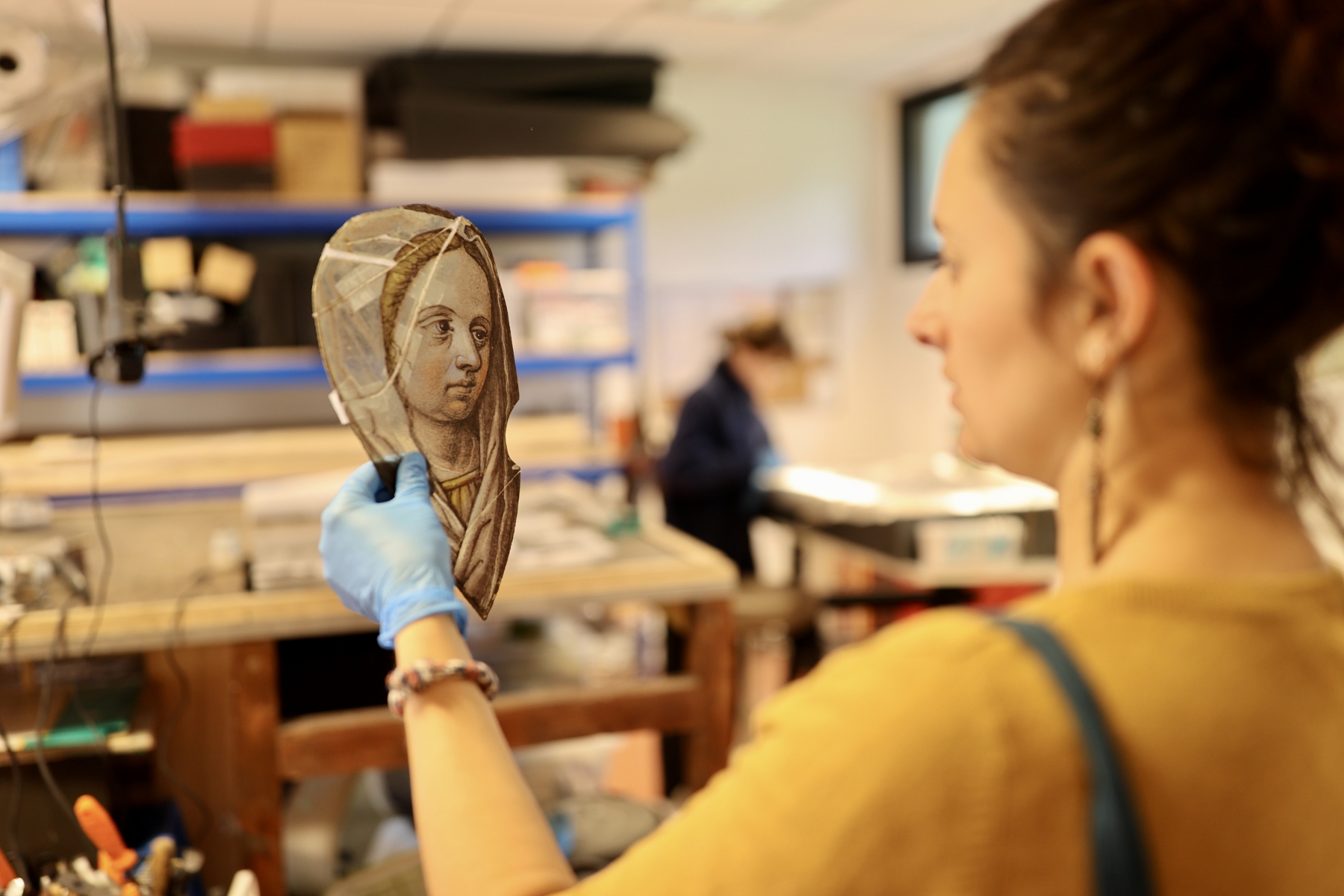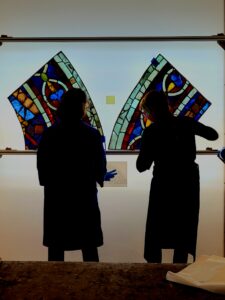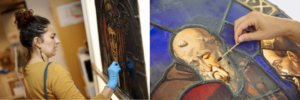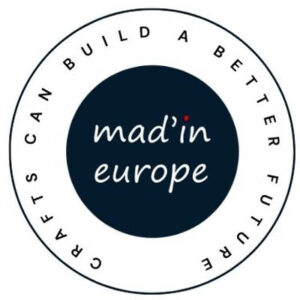This interview is part of a series of interviews with European craftspeople conducted in collaboration between FRH, the European network for Religious Heritage, and Mad’in Europe, the network of European fine and traditional crafts and Cultural Heritage restoration professions.

A glass from the 16th century depicting a virgin under observation by Emma Groult. © Mad’in Europe.
Emma Groult is a stained glass conservator-restorer of heritage stained glass windows. She works mostly on glass heritage from buildings classified as Historic Monuments and Museums of France. She is currently part of the team working on the restoration of the stained glass in Notre Dame de Paris after the damage suffered as a consequence of the fire in 2018. Read on to learn more about her work, the challenges she faces as a professional and her views on how to support professionals in her sector.
1. Please introduce yourself (profession, area of expertise and years of experience).
I am a state-approved stained-glass conservator-restorer and I work mainly with Historic Monuments and Museums. I have been working in this field for nearly 10 years.
2. What clients/markets do you work with (are they local, national or international)? Which needs does your work generally tackle? Which are the required skills and certifications that your customers request?
Our clients are mainly the State and the local communities. We also have private owners of stained-glass windows in historic houses or even condominium associations for stairwells of buildings. Our skills and know-how focus on the issues of conservation-restoration by applying the principles governing the deontology of our profession and our commitment such as those mentioned in the ECCO (European Confederation of Conservator-Restorers Organisations).

A stained glass window of Chartres being restored. © Mad’in Europe.
3. Please briefly explain how your profession is related to religious heritage and/or cultural heritage.
We take part in religious and cultural institutions for their preservation and transmission to the future generations. I am currently working on Notre-Dame in Paris in collaboration with the city, and also work as advisor on the methodology for the maintenance of Parisian religious buildings. With my team we just finished putting back the stained glass windows of Cathedral Notre-Dame de Chartres, after their restoration. In 2021, we restored the stained-glass windows of the rose of Soissons’s Cathedral that fell during a storm.
I can’t really detail the intervention in Notre Dame de Paris, because it is submitted to preliminary authorization, but regarding Chartres, we dealt with altered stained glass windows from the 13th century which presented particularly adherent deposits on the surface. The cleaning was the most complex task to carry out.
4. Please describe the main steps of your usual working process and the materials that you use most.
First, we draw up the general state of the work, we adapt a protocol to the observations and future conditions of conservation of the stained-glass windows. The stained glasses are then cleaned. After that, we restore the glass fractures by gluing, and the lead nets. At the end, we go on site to place back the stained glasses and hand out the full restoration report.
5. Do you regularly cooperate with craft professionals from other fields? If yes, can you explain which ones and why?
Yes, indeed, we often work with locksmiths, woodworkers and stone carvers who produce the structural elements framing the stained glasses.
6. Please mention any innovation that helped improve your work (technological, digital, material related, legal…) and explain the impact they had on your profession.
Nowadays, in restoration, the technological means of observation have evolved and are more accessible to all, which makes the treatments in the workshop much easier.
7. How did you learn the profession? Can you detail your learning path mentioning schools and workshops where you were trained?
At first, I studied applied arts in high school with the objective of joining a school of art in stained glass. I joined the ENSAAMA in Paris, in the stained-glass section. Thereafter, I worked in a workshop while preparing the entrance exam for the Master of Conservation-Restoration of Cultural Properties of Paris-1 Panthéon Sorbonne, still specializing in stained glass.

Left picture: a stained glass window of Chartres being restored.© Mad’in Europe. Right picture: a stained glass window in the cleaning phase.© Mad’in Europe.
8. Do you pass on your knowledge to young people? If yes, how? In schools, through workshops…?
Indeed, I try to transmit as much as possible by welcoming trainees from different educational backgrounds. I also often take part in days of demonstration and presentation of our profession. Finally, I taught for 2 years at the ENSAAMA of Paris in the stained-glass section.
9. What would you recommend to a young person interested in your profession? What are the opportunities and areas in which they can work with your skills?
Those interested in conservation-restoration must first have an approach with the material for which they plan to specialize. This contact with the material through practical training is essential to understand the material in all its aspects.
10. Which are the threats that may endanger your profession? Can you mention some difficulties that are associated with your work? Which could be the solutions to better support your profession and preserve the transmission of skills?
Currently, a European directive is being studied in order to ban lead. But lead is the skeleton, the framework of stained glass. We have no substitutes at our disposal, and we strongly hope that all the trades using this metal will be exempted in order to safeguard the ancestral gestures and know-how of stained glass but also of organ builders, roofers, etc.
You can find out more about Emma Groult and her work on her website as well as on her Mad’in Europe profile.
 Mad’in Europe (MIE) is a small company committed to promoting craft professionals and crafts professions and to supporting the transmission of crafts skills at a European level. Its multilingual portal gathers a large audience around the profiles of 1,500 crafts, restorers and fine crafts professionals. As a member of some European organizations and thanks to its wide European network MIE participates in several transversal activities including Erasmus and Horizon projects which focus on valorisation of crafts, preservation of traditional know-how, and raising awareness among young people, for whom the sector represents a source of employment.
Mad’in Europe (MIE) is a small company committed to promoting craft professionals and crafts professions and to supporting the transmission of crafts skills at a European level. Its multilingual portal gathers a large audience around the profiles of 1,500 crafts, restorers and fine crafts professionals. As a member of some European organizations and thanks to its wide European network MIE participates in several transversal activities including Erasmus and Horizon projects which focus on valorisation of crafts, preservation of traditional know-how, and raising awareness among young people, for whom the sector represents a source of employment.
 Future for Religious Heritage (FRH) is an independent, non-faith, non-profit European network founded in 2011 and based in Brussels to promote, encourage and support the safeguard, maintenance, conservation, restoration, accessibility and embellishment of historic places of worship. Our network represents more than 80 organisations and over 120 professionals from 36 countries, which includes NGOs, governmental organisations, religious and university departments, and individuals. We are one of the 36 European networks currently supported by the Creative Europe Networks programme.
Future for Religious Heritage (FRH) is an independent, non-faith, non-profit European network founded in 2011 and based in Brussels to promote, encourage and support the safeguard, maintenance, conservation, restoration, accessibility and embellishment of historic places of worship. Our network represents more than 80 organisations and over 120 professionals from 36 countries, which includes NGOs, governmental organisations, religious and university departments, and individuals. We are one of the 36 European networks currently supported by the Creative Europe Networks programme.





Follow us: